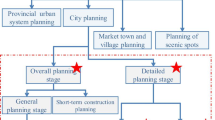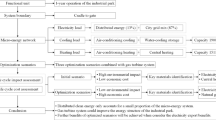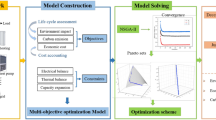Abstract
The existing integrated energy station (IES) planning does not consider the lifecycle of the energy conversion equipment and the growth modes of various loads at the same time, which will inevitably affect the economics of the IES planning. This paper proposes a planning and design of regional IESs that takes the load growth mode into account, aiming at the lowest total cost of regional IESs in the planning lifecycle. Based on the operation mode about of the IES coupled with the three-networks involving the natural gas network (NGN), power distribution network (PDN) and transportation network (TN), the selection and capacity configuration of the equipment in the IES are optimized. The solution process of staged planning for IESs is proposed based on load calculation, power distribution and economic checking computations. The optimization calculation is carried out by reasonably dividing the time interval and setting the calculation criteria for the power distribution module. Finally, four MW-level IESs coupled with IEEE 33-node PDN, 20-node NGN and 12-node TN are simulated on the basis of MATLAB. The results show that the equipment investment and operation costs of the regional IESs can be decreased by about 7.1%, and the accumulated waste of various equipment capacity is decreased by nearly 16.51 MW, which verifies the effectiveness of the proposed model and strategy. Furthermore, the results show that it is more practical and economical to consider the equipment lifecycle and load growth mode for the medium and long-term planning of IESs.











Similar content being viewed by others
References
Zhou C, Ma X, Guo Z, Hu Y (2020) User-level integrated energy system planning for engineering applications. Trans Chin Soc Electr Eng 35:2843–2854
Huang W, Zhang N, Dong R, Liu Y, Kang Z (2018) Coordinated planning of multiple energy networks and energy hubs. Proc CSEE 38:5425–5437
Yang L, Zhang S, Cheng H, Lu J (2022) Key technologies and challenges of regional low-carbon integrated energy system planning. Power Grid Technol 46:3290–3304
Chen Z, Gao Z, Chen JM, Wu X, Fu X, Chen X (2021) Study on collaborative planning of integrated energy system considering uncertainty. Power Syst Protect Control 49:32–40
Chakraborty MR, Dawn S, Saha PK, Basu JB, Ustun TS (2023) System economy improvement and risk shortening by fuel cell-UPFC placement in a wind-combined system. Energies 16:1621
Hu Y, Bie C, Li G, Ding T, Lian H (2017) Integrated planning of natural gas network and composite power system. Proc CSEE 37:45–54
Wang J, Hu Z, Xie S (2019) Expansion planning model of multi-energy system with the integration of active distribution network. Appl Energy 253:113517
Sigalo MB, Das S, Pillai AC, Abusara M (2023) Real-time economic dispatch of CHP systems with battery energy storage for behind-the-meter applications. Energies 16:1274
Yun B, Zhang E, Zhang G, Ma K, Zhang B (2022) Optimal operation of integrated energy system considering integrated demand response and “dual carbon” mechanism. Power Syst Protect Control 50:11–19
Guan L, Chen P, Tang Z, Chen X, Jiang Z (2016) Integrated energy station design considering cold and heat storage. Power Syst Technol 40:2934–2943
Wu K, Gu J, Meng L, Wen H, Ma J (2022) An explainable framework for load forecasting of a regional integrated energy system based on coupled features and multi-task learning. Protect Control of Modern Power Syst 7:24
Zou L, Wang C, Du X, Tang Y, Wu Z, Fang C (2021) Coordinated phased planning of regional integrated energy system considering pipe network selection and power flow constraints. Chin J Electr Eng 41:3765–3781
Zou L, Tang Y, Liu Z, Wu Z, Fang C, Wang C, Wen F (2021) Optimal allocation method of park-type comprehensive energy system considering phased planning and equipment replacement. China Electr Power 54:176–186
Liu H, Zheng N, Ge S, Liu J, Zhang Q, Hu Y (2021) Station and network coordinated planning of integrated energy systems considering complementation of load characteristic. Proc CSEE 41:52–64
Yao Z, Wang Z (2020) Two-level collaborative optimal allocation method of integrated energy system considering wind and solar uncertainty. Power Syst Technol 44:4521–4531
Wang J, Hu Z, Xie S (2020) Smart multi-energy system planning considering the traffic scheduling. Proc CSEE 40:7539–7555
Dai L, Tian L, Wang H, Wang M, Jiang M (2021) Joint planning method of wide area integrated energy system taking into account the comprehensive energy use behavior and policy orientation of users. Power Syst Protect Control 49:57–71
Jiang Y, Zhang J (2022) Multi-stage planning of offshore wind farm considering wind power acceptance level and load growth. Electr Power Autom Equip 42:85–91
Shao Y, Zhao J, Fang J, Chen Y, Liu D, Wang L, Liu Q, Yang Q (2019) Joint dynamic programming of distributed wind power and capacitors based on load classification growth. Power Grid Technol 43:316–324
Liu T, Zhang Q, He C (2021) Coordinated optimal operation of electricity and natural gas distribution system considering integrated electricity-gas demand response. Proc CSEE 41:1664–1676
Li J, Yu G, Tang B, Yang X, Xia X, Liu J, Pan A (2021) Multi-energy flow integrated energy system planning considering wind power utilization and hydrogen-containing energy flow. Power Syst Protect Control 49:11–20
Li X, Li L, Liu W, Zhao X, Xie Q (2020) Prediction of electric vehicle charging load spatiotemporal distribution based on dynamic traffic information. Power Syst Protect Control 48:117–125
Fu X, Wu X, Zhang C, Fan S, Liu N (2022) Planning of distributed renewable energy systems under uncertainty based on statistical machine learning. Protect Control Modern Power Syst 7:41
Ospina J, Fobes DM, Bent R (2023) On the feasibility of market manipulation and energy storage arbitrage via load-altering attacks. Energies 16:1670
Wei W, Wu L, Wang J, Mei S (2017) Expansion planning of urban electrified transportation networks: a mixed-integer convex programming approach. IEEE Trans Transp Electr 3:210–224
Ma T, Wu J, Hao L, Lee W, Yan H, Li D (2018) The optimal structure planning and energy management strategies of smart multi energy systems. Energy 160:122–141
Funding
This research is funded by the National Key Research and Development Program of China Funding Projects (2018YFB1503001), and the fund of Shanghai Municipal Commission of Economy and Informatization Industrial Foundation Strengthening Plan Project (GYQJ-2022-1-14).
Author information
Authors and Affiliations
Contributions
Writing and editing were contributed by ZY; review was contributed by BY; review was contributed by CG; funding acquisition was contributed by DX; funding acquisition was contributed by JB; funding acquisition was contributed by LZ; funding acquisition was contributed by GC; funding acquisition was contributed by HC; supervision and project administration were contributed by ZW. All authors have read and agreed to the published version of the manuscript.
Corresponding author
Ethics declarations
Conflict of interest
The authors declare no conflict of interest. The funders had no role in the design of the study; in the collection, analyses, or interpretation of data; in the writing of the manuscript; or in the decision to publish the results.
Additional information
Publisher's Note
Springer Nature remains neutral with regard to jurisdictional claims in published maps and institutional affiliations.
Appendices
Appendix A
Simulation data
See Tables 6, 7, 8, 9 and Figs. 12, 13.
Appendix B
Equations
-
(1)
TN constraints are as follows:
$$x_{a,\omega } = \sum\limits_{{rs \in \Lambda^{{{\text{OD}}}} }} {\sum\limits_{{k \in K_{rs}^{{{\text{CV}}}} }} {f_{rs,k,\omega }^{{{\text{CV}}}} \delta_{rs,k,a}^{{{\text{CV}}}} } } + \sum\limits_{{rs \in \Lambda^{{{\text{OD}}}} }} {\sum\limits_{{k \in K_{rs}^{{\text{N - CV}}} }} {f_{rs,k,\omega }^{{\text{N - CV}}} \delta_{rs,k,a}^{{\text{N - CV}}} } } ,\forall a \in \Theta^{{{\text{TL}}}} ,\forall \omega$$(B1)$$\sum\limits_{{k \in K_{rs}^{{{\text{CV}}}} }} {f_{rs,k,\omega }^{{{\text{CV}}}} } { = }m_{rs,\omega }^{{{\text{CV}}}} ,\forall rs \in \Lambda^{{{\text{OD}}}} ,\forall \omega$$(B2)$$\sum\limits_{{k \in K_{rs}^{{\text{N - CV}}} }} {f_{rs,k,\omega }^{{\text{N - CV}}} } { = }m_{rs,\omega }^{{\text{N - CV}}} ,\forall rs \in \Lambda^{{{\text{OD}}}} ,\forall \omega$$(B3)$$f_{rs,k,\omega }^{{{\text{CV}}}} \ge 0,\forall rs \in \Lambda^{{{\text{OD}}}} ,\forall k \in K_{rs}^{{{\text{CV}}}} ,\forall \omega$$(B4)$$f_{rs,k,\omega }^{{\text{N - CV}}} \ge 0,\forall rs \in \Lambda^{{{\text{OD}}}} ,\forall k \in K_{rs}^{{\text{N - CV}}} ,\forall \omega$$(B5)$$c_{rs,k,\omega }^{{{\text{CV}}}} = \sum\limits_{{a \in \Theta^{TL} }} {t_{a,\omega } \cdot\delta_{rs,k,a}^{{{\text{CV}}}} } ,\forall k \in K_{rs}^{{{\text{CV}}}} ,\forall \omega$$(B6)$$c_{rs,k,\omega }^{{N - {\text{CV}}}} = \sum\limits_{{a \in \Theta^{TL} }} {t_{a,\omega } \cdot\delta_{rs,k,a}^{{N - {\text{CV}}}} } ,\forall k \in K_{rs}^{{N - {\text{CV}}}} ,\forall \omega$$(B7)$$t_{a,\omega } (x_{a,\omega } ) = \left\{ \begin{gathered} t_{a,\omega }^{0} [1 + J_{{\text{R}}} .(\frac{{x_{a,\omega } }}{{\overline{C}_{a}^{{{\text{TL}}}} }})^{4} ],\forall a \in \Theta^{{\text{TL - R}}} \hfill \\ t_{a,\omega }^{0} (1 + J_{{\text{C}}} .\frac{{x_{a,\omega } }}{{\overline{C}_{a}^{{{\text{TL}}}} - x_{a,\omega } }}),\forall a \in \Theta^{{\text{TL - C}}} \hfill \\ \end{gathered} \right.,\forall \omega$$(B8)
In (B1)–(B8), \(\Lambda^{{{\text{OD}}}}\) is the set of O–D pairs of traffic demand; \(K_{rs}^{{{\text{CV}}}} /K_{rs}^{{\text{N - CV}}}\) is the set of feasible paths from the starting point r to the ending point s; \(f_{rs,k,\omega }^{{{\text{CV}}}} /f_{rs,k,\omega }^{{\text{N - CV}}}\) is the flow of O–D to path k under r-s in the \(\omega\) period; \(\delta_{rs,k,a}^{{{\text{CV}}}} /\delta_{rs,k,a}^{{\text{N - CV}}}\) is the correlation coefficient between the section and the path; \(m_{rs,\omega }^{{{\text{CV}}}} /m_{rs,\omega }^{{\text{N - CV}}}\) is the traffic demand of O–D under r-s in the \(\omega\) period; \(c_{rs,k,\omega }^{{{\text{CV}}}} /c_{rs,k,\omega }^{{\text{N - CV}}}\) is the time cost of route travel of O–D to path k under r-s in the \(\omega\) period; \(t_{a,\omega }^{0}\) is the average passing time when the road section has zero flow; \(\overline{C}_{a}^{{{\text{TL}}}}\) is the maximum traffic capacity of the section; \(J_{{\text{R}}}\), \(J_{{\text{C}}}\) are the shape parameters of the time function.
-
(B)
NGN constraints are as follows:
The natural gas network is mainly composed of gas wells, pipelines, pressurizers, and loads. The following constraints should be considered in natural gas network modeling
-
(1)
Gas well supply constraints
$$\underline{G}_{j,\omega }^{{\text{W}}} \le g_{j,\omega }^{{\text{W}}} \le \overline{G}_{j,\omega }^{{\text{W}}} ,\forall j \in \Theta^{{{\text{GW}}}} ,\forall \omega$$(B9)
In (B9), \(\underline{G}_{j,\omega }^{{\text{W}}} ,\overline{G}_{j,\omega }^{{\text{W}}}\) are, respectively, the lower and upper limits of the natural gas quantity that can be supplied by the gas well j during the time period \(\omega\).
-
(B)
Pressure constraint
$$\hat{\pi }_{1,\omega } = C,\forall \omega$$(B10)$$\underline{\Pi }_{j} \le \hat{\pi }_{j,\omega } \le \overline{\Pi }_{j} ,\forall j \in \Theta^{{{\text{GN}}}} ,\forall \omega$$(B11)
In (B10)–(B11), \(C\) is a constant; \(\hat{\pi }_{j,\omega }\) is the square of the gas pressure of the natural gas node j during the time period \(\omega\); \(\underline{\Pi }_{j}\) and \(\overline{\Pi }_{j}\) are, respectively, the square of their lower and upper limits; \(\Theta^{{{\text{GN}}}}\) represents a collection of natural gas nodes.
-
(C)
Constraints on maximum pipeline flow
$$\underline{G}_{ij,\omega } \le g_{ij,\omega } \le \overline{G}_{ij,\omega } ,\forall ij \in \Theta^{{{\text{GP}}}} ,\forall \omega$$(B12)
In (B12), \(g_{ij,\omega }\) is the flow rate of natural gas pipeline ij; \(\underline{G}_{ij,\omega }\) and \(\overline{G}_{ij,\omega }\) are the lower and upper limit, respectively; \(\Theta^{{{\text{GP}}}}\) represents a collection of natural gas pipelines.
-
(D)
Natural gas pipeline flow model
$${\text{sgn}} (\hat{\pi }_{i,\omega } - \hat{\pi }_{j,\omega } )g_{ij,\omega }^{2} = \psi_{ij} (\hat{\pi }_{i,\omega } - \hat{\pi }_{j,\omega } ),\forall ij \in \Theta^{{{\text{GP}}}} ,\forall \omega$$(B13)
The above equation is Weymouth steady-state power flow equation, which is used to describe the relationship between the gas flow in the natural gas pipeline and the pressure of the nodes at both ends. Where: \({\text{sgn}} (x)\) represents the symbolic function about \(x\); \(\psi_{ij}\) is the airflow transmission parameter of the pipeline ij.
-
(E)
Constraints on node traffic balance
$$\sum\limits_{{jk \in \Omega^{{\text{G - JK}}} (j)}} {g_{jk,\omega } } = \sum\limits_{{ij \in \Omega^{{\text{G - IJ}}} (j)}} {g_{ij,\omega } + g_{j,\omega }^{{\text{W}}} } - g_{j,\omega }^{{\text{L}}} ,\forall j \in \Theta^{{{\text{GN}}}} ,\forall \omega$$(B14)
The above formula ensures the flow balance of natural gas nodes. Where, \(\Omega^{{\text{G - JK}}} (j)\) and \(\Omega^{{\text{G - IJ}}} (j)\), respectively, represent a collection of first and last nodes of natural gas pipelines j; \(g_{j,\omega }^{{\text{L}}}\) is the natural gas load of natural gas node j in time period \(\omega\).
-
(F)
Compression device constraints
$$\hat{\pi }_{i,\omega } = \hat{\Phi }_{ij} \hat{\pi }_{j,\omega } ,\forall ij \in \Theta^{{{\text{GC}}}} ,\forall \omega$$(B15)$$\underline{G}_{ij,\omega }^{{\text{C}}} \le g_{ij,\omega }^{{\text{C}}} \le \overline{G}_{ij,\omega }^{{\text{C}}} ,\forall ij \in \Theta^{{{\text{GC}}}} ,\forall \omega$$(B16)
In (B15)–(B16), \(\hat{\Phi }_{ij}\) is the square of the boost ratio of the natural gas node; \(g_{ij,\omega }^{{\text{C}}}\) is the air flow through between i to j and in the pressurizer; \(\underline{G}_{ij,\omega }^{{\text{C}}}\)、\(\overline{G}_{ij,\omega }^{{\text{C}}}\) are, respectively, their lower and upper limits; \(\Theta^{{{\text{GC}}}}\) is a collection of compression device.
-
(1)
PDN constraints are as follows:
Distribution network constraints mainly include power flow constraints, safe operation constraints and load reduction constraints, which are, respectively, expressed as follows:
-
(1)
Power flow constraint
$$\sum\limits_{{jk \in \Omega^{{\text{E - JK}}} (j)}} {p_{jk,\omega } } = \sum\limits_{{ij \in \Omega^{{\text{E - IJ}}} (j)}} {p_{ij,\omega } } - \sum\limits_{{ij \in \Omega^{{\text{E - IJ}}} (j)}} {\hat{I}_{ij,\omega } R_{ij} } + p_{j,\omega }^{{{\text{TS}}}} - p_{j,\omega }^{{\text{L}}} ,\forall j \in \Theta^{{{\text{EB}}}} ,\forall \omega$$(B17)$$\sum\limits_{{ij \in \Omega^{{\text{E - JK}}} (j)}} {q_{jk,\omega } } = \sum\limits_{{ij \in \Omega^{{\text{E - IJ}}} (j)}} {q_{ij,\omega } } - \sum\limits_{{ij \in \Omega^{{\text{E - IJ}}} (j)}} {\hat{I}_{ij,\omega } X_{ij} } + q_{j,\omega }^{{{\text{TS}}}} - q_{j,\omega }^{{\text{L}}} ,\forall j \in \Theta^{{{\text{EB}}}} ,\forall \omega$$(B18)$$\hat{U}_{j,\omega } = \hat{U}_{i,\omega } - 2(p_{ij,\omega } R_{ij} + q_{ij,\omega } X_{ij} ) + \hat{I}_{ij,\omega } (R_{ij}^{2} + X_{ij}^{2} ),\forall ij \in \Theta^{{{\text{EL}}}} ,\forall \omega$$(B19)$$\hat{U}_{i,\omega } \hat{I}_{ij,\omega } = p_{ij,\omega }^{2} + q_{ij,\omega }^{2} ,\forall ij \in \Theta^{{{\text{EL}}}} ,\forall \omega$$(B20)
In (B17)–(B20), \(\Omega^{{\text{E - JK}}} (j)\) and \(\Omega^{{\text{E - IJ}}} (j)\), respectively, represent the set of power grid feeders whose first and last nodes are j; \(p_{ij,\omega }\) and \(q_{ij,\omega }\), respectively, represent the active power and reactive power on the feeder ij; \(X_{ij}\) is the reactance of the feeder; \(\hat{U}_{j,\omega }\) is the square of the grid node j voltage.
-
(B)
Constraints on safe and stable operation
$$\underline{U} \le \hat{U}_{j,\omega } \le \overline{U} ,\forall j \in \Theta^{{{\text{EB}}}} ,\forall \omega$$(B21)$$0 \le \hat{I}_{ij,\omega } \le \overline{I} ,\forall ij \in \Theta^{{{\text{EL}}}} ,\forall \omega$$(B22)$$\underline{P}_{j}^{{{\text{TS}}}} \le p_{j,\omega }^{{{\text{TS}}}} \le \overline{P}_{j}^{{{\text{TS}}}} ,\forall j \in \Theta^{{{\text{TS}}}} ,\forall \omega$$(B23)$$\underline{Q}_{j}^{{{\text{TS}}}} \le q_{j,\omega }^{{{\text{TS}}}} \le \overline{Q}_{j}^{{{\text{TS}}}} ,\forall j \in \Theta^{{{\text{TS}}}} ,\forall \omega$$(B24)
In (B21)–(B24), \(\underline{U}\) and \(\overline{U}\) are, respectively, the square of the lower and upper limits of the voltage amplitude of the grid node j; \(\overline{I}\) is the square of the upper limit of current amplitude; \(\underline{P}_{j}^{{{\text{TS}}}}\) and \(\overline{P}_{j}^{{{\text{TS}}}}\), respectively, represent the lower and upper limits of the available active power of the substation j; \(\underline{Q}_{j}^{{{\text{TS}}}}\) and \(\overline{Q}_{j}^{{{\text{TS}}}}\) are, respectively, the lower and upper limits of the available reactive power of the substation j.
Rights and permissions
Springer Nature or its licensor (e.g. a society or other partner) holds exclusive rights to this article under a publishing agreement with the author(s) or other rightsholder(s); author self-archiving of the accepted manuscript version of this article is solely governed by the terms of such publishing agreement and applicable law.
About this article
Cite this article
Yao, Z., Yang, B., Gong, C. et al. Planning and design of regional integrated energy station considering load growth mode. Electr Eng 105, 3085–3104 (2023). https://doi.org/10.1007/s00202-023-01858-8
Received:
Accepted:
Published:
Issue Date:
DOI: https://doi.org/10.1007/s00202-023-01858-8






